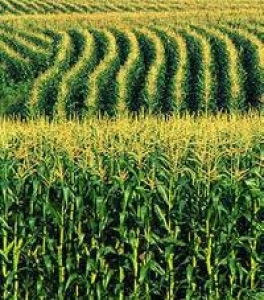Feeds for dairy cows
High Priced Corn and Dairy Cow Rations

Changes in its price, therefore, can have a significant impact on total feed costs. Even with high corn prices, however, it is unlikely that corn grain will be removed completely from the ration.
Corn grain, due to its high starch content, permits the formulation of energy-dense rations required by cows with high genetic merit for milk production. Adequate starch concentrations in corn grain also promote growth of rumen bacteria and protozoa essential for optimum forage fermentation. On the other hand, too much starch in the rumen may result in sub-clinical and/or clinical rumen acidosis. The low protein concentration in corn grain could be considered a disadvantage from a nutritional standpoint although this feature turns out to work in the nutritionist’s favor.
Corn protein is deficient in the amino acid lysine. As a result, there is a need for high quality forages (e.g. alfalfa) and co-products that will supply additional lysine in the diet. But if low-protein corn did not dilute the alfalfa and co-products, the protein requirements of the lactating dairy cow could be exceeded and the excess protein would be excreted to the environment as nitrogen in urine and feces. Corn can be considered an “ideal” feedstuff. But what if corn prices go up more than you want to see?
Economics of using corn and forages
According to the NRC (2001), a dairy cow producing 77 lb of milk requires only 15.2% protein in the ration. If corn grain was to be replaced entirely by a high protein co-product such as distillers grains (30% CP), this would limit the alfalfa hay and/or silage that could be included, so that the protein and phosphorus requirements of the cow would not be exceeded.
Corn silage then becomes a natural choice as the primary forage in rations where corn grain is partially removed. Corn silage is low in protein and provides fermentable starch, energy, and relative amounts of effective fiber (depending on its particle size).
From a dairy producer’s economic standpoint, the question is whether—with the current corn prices and speculations about futures—increasing the acreage devoted to corn silage would be a sound economic strategy compared to corn planted for grain and sold as a cash crop.
A $1 increase per bushel of corn will increase the average dairy cow ration cost between 27 and 34 cents per day. This will afffect various measures of economic returns, including, for example, the milk-feed price ratio. This ratio represents the pounds of 16% protein mixed dairy feed equal in value to 1 pound of whole milk.Whenever the ratio meets or exceeds 3.0, it is considered profitable to buy feed and produce milk (USDA). The feed price is calculated using the following formula, and average corn, soybean, and hay prices:

Although all three feedstuffs used in the calculation do not constitute an entire lactating cow ration, they are among the most common feedstuffs used to provide energy, protein, and forage. As of the end of 2006, a producer could buy 2.42 lb of feed per pound of milk sold, which represents 0.86 lb less feed purchased per pound of milk sold than in the previous year. Prices used for this calculation were corn at $3.01/bu, soybeans at $6.14/bu, alfalfa hay at $112/ton, and milk at $14.20/hundredweight (USDA).
The milk-feed price ratio is highly dependent on the current cost of all three feedstuffs and milk price. If we consider current corn prices close to $3.50/bu and all other variables remaining relatively constant, the current ratio would be 2.27, well below what’s considered profitable to buy feed to produce milk. This, of course, assumes a relatively stable milk price and that the potential increase in the demand for alfalfa hay will not significantly modify its price. If feed prices stabilize at current values, milk would have to be priced at $18.5 per hundredweight to have a “profitable” 3.0 milk-feed price ratio!
Importance of forage digestibility
If you plan to decrease grain supplementation and still sustain high levels of milk production, you need to select highly digestible forages. Forage fiber represents the largest nutrient fraction in a dairy ration. At the same time it presents the greatest variation in digestibility. In ruminant diets, this fraction is analyzed as neutral detergent fiber (NDF) and acid detergent fiber (ADF). The residue in the NDF is negatively correlated with feed intake.
Analyzing samples for NDF digestibility (NDFD) will provide an estimation of the energy the cow is able to obtain from that forage. For example, an increase in 1 percentage unit in NDFD results in 0.37 lb increase in forage dry matter intake per day (Hoffman and Bauman 2003). Oba and Allen (1999) also reported that a one percentage unit increase for forage NDF digestibility resulted in 0.37 lb/day increase in DM intake and a 0.55 lb/day increase in 4% FCM yield. Jung et al. (2004) reported that when in vitro NDFD of corn silage increased by one unit, dairy cows ate 0.26 lb/d more DM and produced 0.31 1b/d more 3.5% FCM.
Cows fed forages with greater NDFD are able to eat more and obtain more total energy from the forages. This results from a faster emptying of the rumen, which reduces distension and allows for even greater feed intake. As a result energy requirements can be fulfilled with less grain required in the diet.





















